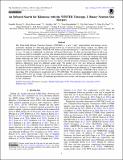| dc.contributor.author | Frostig, Danielle | |
| dc.contributor.author | Biscoveanu, Sylvia | |
| dc.contributor.author | Mo, Geoffrey | |
| dc.contributor.author | Karambelkar, Viraj | |
| dc.contributor.author | Dal Canton, Tito | |
| dc.contributor.author | Chen, Hsin-Yu | |
| dc.contributor.author | Kasliwal, Mansi | |
| dc.contributor.author | Katsavounidis, Erik | |
| dc.contributor.author | Lourie, Nathan P | |
| dc.contributor.author | Simcoe, Robert A | |
| dc.contributor.author | Vitale, Salvatore | |
| dc.date.accessioned | 2022-04-29T16:35:54Z | |
| dc.date.available | 2022-04-29T16:35:54Z | |
| dc.date.issued | 2022-02-01 | |
| dc.identifier.uri | https://hdl.handle.net/1721.1/142206 | |
| dc.description.abstract | The Wide-Field Infrared Transient Explorer (WINTER) is a new 1 deg2 seeing-limited time-domain survey instrument designed for dedicated near-infrared follow-up of kilonovae from binary neutron star (BNS) and neutron star–black hole mergers. WINTER will observe in the near-infrared Y, J, and short-H bands (0.9–1.7 μm, to JAB = 21 mag) on a dedicated 1 m telescope at Palomar Observatory. To date, most prompt kilonova follow-up has been in optical wavelengths; however, near-infrared emission fades more slowly and depends less on geometry and viewing angle than optical emission. We present an end-to-end simulation of a follow-up campaign during the fourth observing run (O4) of the LIGO, Virgo, and KAGRA interferometers, including simulating 625 BNS mergers, their detection in gravitational waves, low-latency and full parameter estimation skymaps, and a suite of kilonova lightcurves from two different model grids. We predict up to five new kilonovae independently discovered by WINTER during O4, given a realistic BNS merger rate. Using a larger grid of kilonova parameters, we find that kilonova emission is ≈2 times longer lived and red kilonovae are detected ≈1.5 times further in the infrared than in the optical. For 90% localization areas smaller than 150 (450) deg2, WINTER will be sensitive to more than 10% of the kilonova model grid out to 350 (200) Mpc. We develop a generalized toolkit to create an optimal BNS follow-up strategy with any electromagnetic telescope and present WINTER's observing strategy with this framework. This toolkit, all simulated gravitational-wave events, and skymaps are made available for use by the community. | en_US |
| dc.language.iso | en | |
| dc.publisher | American Astronomical Society | en_US |
| dc.relation.isversionof | 10.3847/1538-4357/ac4508 | en_US |
| dc.rights | Creative Commons Attribution 4.0 International License | en_US |
| dc.rights.uri | https://creativecommons.org/licenses/by/4.0 | en_US |
| dc.source | American Astronomical Society | en_US |
| dc.title | An Infrared Search for Kilonovae with the WINTER Telescope. I. Binary Neutron Star Mergers | en_US |
| dc.type | Article | en_US |
| dc.identifier.citation | Frostig, Danielle, Biscoveanu, Sylvia, Mo, Geoffrey, Karambelkar, Viraj, Dal Canton, Tito et al. 2022. "An Infrared Search for Kilonovae with the WINTER Telescope. I. Binary Neutron Star Mergers." The Astrophysical Journal, 926 (2). | |
| dc.contributor.department | Massachusetts Institute of Technology. Department of Physics | |
| dc.contributor.department | LIGO (Observatory : Massachusetts Institute of Technology) | |
| dc.contributor.department | MIT Kavli Institute for Astrophysics and Space Research | |
| dc.relation.journal | The Astrophysical Journal | en_US |
| dc.eprint.version | Final published version | en_US |
| dc.type.uri | http://purl.org/eprint/type/JournalArticle | en_US |
| eprint.status | http://purl.org/eprint/status/PeerReviewed | en_US |
| dc.date.updated | 2022-04-29T16:30:01Z | |
| dspace.orderedauthors | Frostig, D; Biscoveanu, S; Mo, G; Karambelkar, V; Dal Canton, T; Chen, H-Y; Kasliwal, M; Katsavounidis, E; Lourie, NP; Simcoe, RA; Vitale, S | en_US |
| dspace.date.submission | 2022-04-29T16:30:03Z | |
| mit.journal.volume | 926 | en_US |
| mit.journal.issue | 2 | en_US |
| mit.license | PUBLISHER_CC | |
| mit.metadata.status | Authority Work and Publication Information Needed | en_US |
